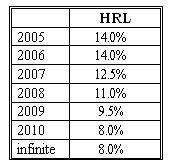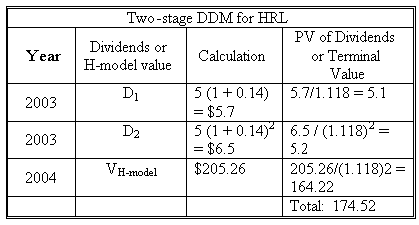Why should I choose AnalystNotes?
Simply put: AnalystNotes offers the best value and the best product available to help you pass your exams.
Basic Question 3 of 7
Beth is evaluating HRL Co. which started its business two years ago. Last year its growth was 14%. The risk-free rate is 4% and expected equity premium is 6%. Here is her forecast of the company's future dividend growth trend.

After considerable study, she has decided to use the following information in her valuation (as of the end of 2004):
- Beta: 1.3.
- 2004 dividend: $5.
- The risk-free rate: 4%.
- Expected equity premium: 6%.
What is the value of the HRL's stock?
User Contributed Comments 9
| User | Comment |
|---|---|
| danlan2 | We can not use H-Model from 2004, but can use it from 2006, since the growth rate change is not constant. |
| Smiley225 | agree, possibly a typo. But use H-model to 2006 value, then PV back to 2004. Then dont forget to PV the 2 dividends in 2005 and 2006. |
| rhardin | I worked this out using the cashflow function in my calculator and got 316.70. Did any one else try to work it out manually? |
| REITboy | Worked it out manually, and got $170.34 based on the following CFs, beginning with C01: 5.70, 6.50, 7.31, 8.11, 8.89, and 9.60+272.63=282.23. |
| arudkov | 2 EITboy - got almost the same (rounding influenced, CF1 5.675) |
| quanttrader | use the H model from beg of yr 2007 to end of year 2010; ie H = 4 /2 =2. and then discount value back 2 years along with previous dividends. |
| quanttrader | discount the H model terminal value by 2 periods (end of year 2006 to end of 2004), the 2006 dividend by 2 periods, and the 2005 dividend by 1 period. |
| philjoe | I also got 170.34 doing it manually... |
| davidt876 | you guys realise you're not supposed to be doing it 'normally' - right? they explicitly ask you to calculate using the H-model on the exam, so you need to know how to use it. if you're not sure why the answers come out different, read the first 2 paragraphs of my answer on the previous question. |

I passed! I did not get a chance to tell you before the exam - but your site was excellent. I will definitely take it next year for Level II.

Tamara Schultz
Learning Outcome Statements
explain the assumptions and justify the selection of the two-stage DDM, the H-model, the three-stage DDM, or spreadsheet modeling to value a company's common shares;
describe terminal value and explain alternative approaches to determining the terminal value in a DDM;
calculate and interpret the value of common shares using the two-stage DDM, the H-model, and the three-stage DDM;
explain the use of spreadsheet modeling to forecast dividends and to value common shares;
evaluate whether a stock is overvalued, fairly valued, or undervalued by the market based on a DDM estimate of value.
CFA® 2025 Level II Curriculum, Volume 3, Module 21.
